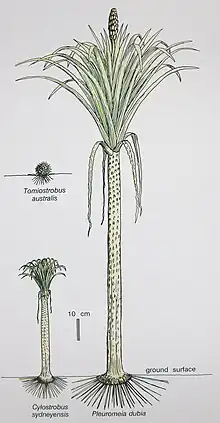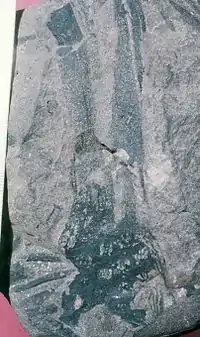| Pleuromeia dubia Temporal range: | |
|---|---|
 | |
| Life restoration | |
| Scientific classification | |
| Kingdom: | Plantae |
| Clade: | Tracheophytes |
| Clade: | Lycophytes |
| Class: | Lycopodiopsida |
| Order: | Isoetales |
| Family: | †Pleuromeiaceae |
| Genus: | †Pleuromeia |
| Species: | †P. dubia |
| Binomial name | |
| †Pleuromeia dubia (Anderson and Anderson, 1985) | |
| Synonyms | |
|
Gregicaulis dubius | |
Pleuromeia dubia is a tall species for the genus, with distinctive elongate leaf scars, and known from the Early Triassic of Australia and South Africa. Like other species of Pleuromeia it was a survivor of the marked greenhouse spike at the end of the Early Triassic.[1] It was originally assigned to the genus Gregicaulis, and its placement in the genus Pleuromeia has been questioned, due to its significant differences to the core Eurasian members of the genus.[2]

leafy apex of Pleuromeia dubia from the Early Triassic Newport Formation near Newport, NSW
See also
References
- ↑ Retallack, Gregory J. (2013). "Permian and Triassic greenhouse crises". Gondwana Research. 24: 90–103. doi:10.1016/j.gr.2012.03.003.
- ↑ Deng, Shenghui; Lu, Yuanzheng; Fan, Ru; Ma, Xueying; Lyu, Dan; Luo, Zhong; Sun, Yanqi (December 2022). "A new species of Pleuromeia (Lycopsid) from the upper Middle Triassic of Northern China and discussion on the spatiotemporal distribution and evolution of the genus". Geobios. 75: 1–15. doi:10.1016/j.geobios.2022.10.001.
This article is issued from Wikipedia. The text is licensed under Creative Commons - Attribution - Sharealike. Additional terms may apply for the media files.